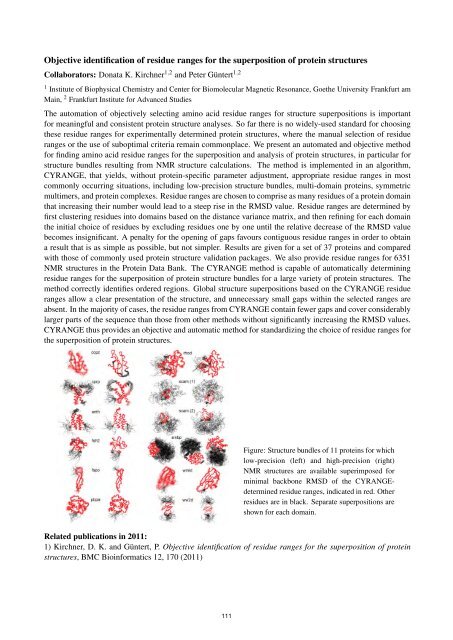FIAS Scientific Report 2011 - Frankfurt Institute for Advanced Studies ...
FIAS Scientific Report 2011 - Frankfurt Institute for Advanced Studies ...
FIAS Scientific Report 2011 - Frankfurt Institute for Advanced Studies ...
Create successful ePaper yourself
Turn your PDF publications into a flip-book with our unique Google optimized e-Paper software.
Objective identification of residue ranges <strong>for</strong> the superposition of protein structures<br />
Collaborators: Donata K. Kirchner 1,2 and Peter Güntert 1,2<br />
1 <strong>Institute</strong> of Biophysical Chemistry and Center <strong>for</strong> Biomolecular Magnetic Resonance, Goethe University <strong>Frankfurt</strong> am<br />
Main, 2 <strong>Frankfurt</strong> <strong>Institute</strong> <strong>for</strong> <strong>Advanced</strong> <strong>Studies</strong><br />
The automation of objectively selecting amino acid residue ranges <strong>for</strong> structure superpositions is important<br />
<strong>for</strong> meaningful and consistent protein structure analyses. So far there is no widely-used standard <strong>for</strong> choosing<br />
these residue ranges <strong>for</strong> experimentally determined protein structures, where the manual selection of residue<br />
ranges or the use of suboptimal criteria remain commonplace. We present an automated and objective method<br />
<strong>for</strong> finding amino acid residue ranges <strong>for</strong> the superposition and analysis of protein structures, in particular <strong>for</strong><br />
structure bundles resulting from NMR structure calculations. The method is implemented in an algorithm,<br />
CYRANGE, that yields, without protein-specific parameter adjustment, appropriate residue ranges in most<br />
commonly occurring situations, including low-precision structure bundles, multi-domain proteins, symmetric<br />
multimers, and protein complexes. Residue ranges are chosen to comprise as many residues of a protein domain<br />
that increasing their number would lead to a steep rise in the RMSD value. Residue ranges are determined by<br />
first clustering residues into domains based on the distance variance matrix, and then refining <strong>for</strong> each domain<br />
the initial choice of residues by excluding residues one by one until the relative decrease of the RMSD value<br />
becomes insignificant. A penalty <strong>for</strong> the opening of gaps favours contiguous residue ranges in order to obtain<br />
a result that is as simple as possible, but not simpler. Results are given <strong>for</strong> a set of 37 proteins and compared<br />
with those of commonly used protein structure validation packages. We also provide residue ranges <strong>for</strong> 6351<br />
NMR structures in the Protein Data Bank. The CYRANGE method is capable of automatically determining<br />
residue ranges <strong>for</strong> the superposition of protein structure bundles <strong>for</strong> a large variety of protein structures. The<br />
method correctly identifies ordered regions. Global structure superpositions based on the CYRANGE residue<br />
ranges allow a clear presentation of the structure, and unnecessary small gaps within the selected ranges are<br />
absent. In the majority of cases, the residue ranges from CYRANGE contain fewer gaps and cover considerably<br />
larger parts of the sequence than those from other methods without significantly increasing the RMSD values.<br />
CYRANGE thus provides an objective and automatic method <strong>for</strong> standardizing the choice of residue ranges <strong>for</strong><br />
the superposition of protein structures.<br />
Figure: Structure bundles of 11 proteins <strong>for</strong> which<br />
low-precision (left) and high-precision (right)<br />
NMR structures are available superimposed <strong>for</strong><br />
minimal backbone RMSD of the CYRANGEdetermined<br />
residue ranges, indicated in red. Other<br />
residues are in black. Separate superpositions are<br />
shown <strong>for</strong> each domain.<br />
Related publications in <strong>2011</strong>:<br />
1) Kirchner, D. K. and Güntert, P. Objective identification of residue ranges <strong>for</strong> the superposition of protein<br />
structures, BMC Bioin<strong>for</strong>matics 12, 170 (<strong>2011</strong>)<br />
111
















